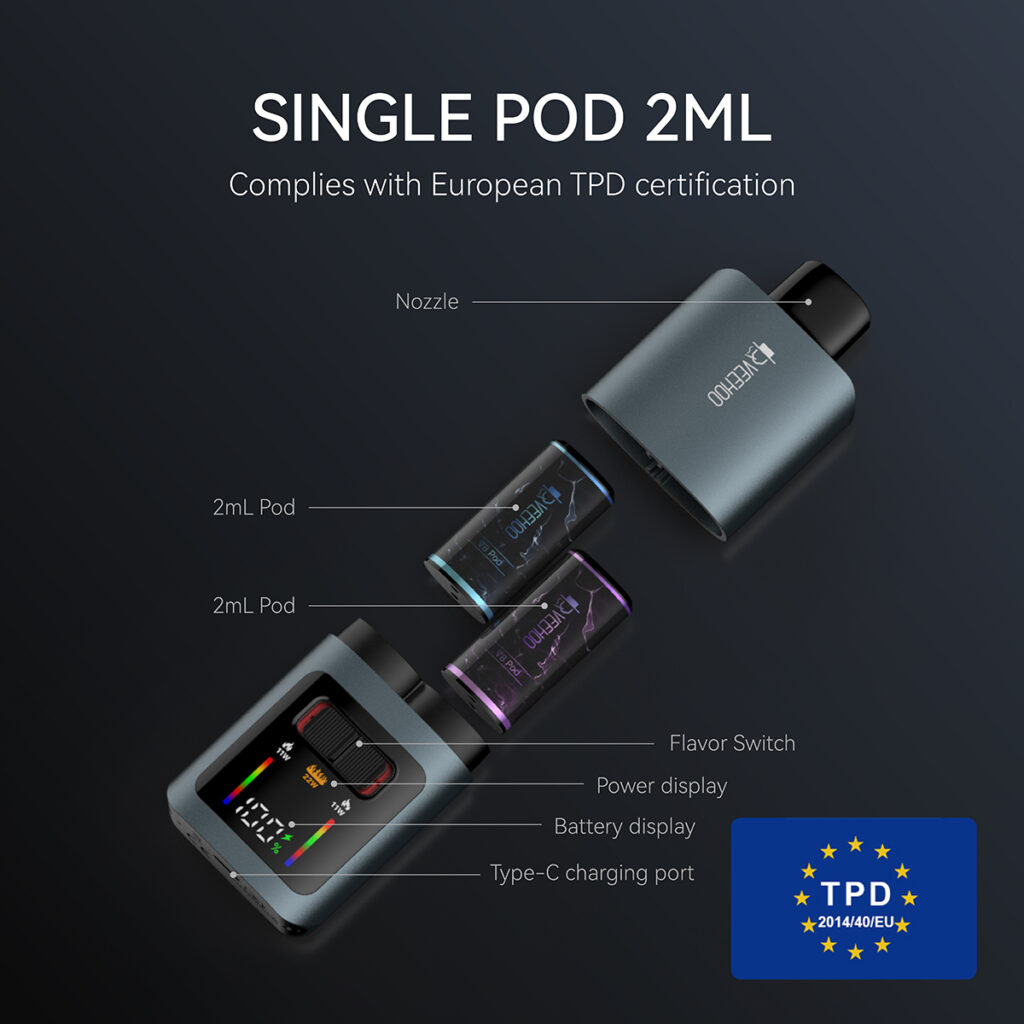One morning, while many were still drowsy, a major World Health Organization (WHO) report quietly released, sending shockwaves through the global health and public opinion communities. This time, the WHO released the latest global e-cigarette data: the number of e-cigarette users has surpassed 100 million, and the risk among adolescents is approximately nine times higher than that of adults. Once released, the news spread like wildfire, striking a nerve with governments, public health agencies, parents, and the media.
Opening the report, even clearer figures emerged: Globally, at least 86 million adults use e-cigarettes, while at least 15 million adolescents aged 13 to 15 currently use them. In countries with available data, adolescents are, on average, nine times more likely to use e-cigarettes than adults. This was the first global estimate released by the WHO, and it represents a new reality that the public health sector must confront.
While these statistics are alarming, they also serve as a reminder that e-cigarettes, as “new nicotine products,” are rapidly entering the public consciousness and potentially presenting far greater health, social, and regulatory challenges than ever before. For adolescents, this isn’t just a statistical issue; it potentially means that many immature brains are being seduced by nicotine, seduced by the e-cigarette industry’s hype, convenience, and fashionable packaging, and sliding towards the risk of addiction.

More broadly, the World Health Organization (WHO) has noted that while the number of traditional tobacco users worldwide has declined in recent years (from 1.38 billion in 2000 to 1.2 billion in 2024), the tobacco industry is shifting its focus to alternatives like e-cigarettes, heat-not-burn products, and nicotine gum to maintain its market share and profits. Against this backdrop, some stakeholders are frequently using the narrative that e-cigarettes are being marketed as “harm reduction tools.” However, the WHO clearly expresses reservations about this narrative, expressing concern that it could potentially be used to lure minors and new users and potentially expand the market.
Faced with such data and controversy, all sectors of society must examine: In an era of rapid expansion and technological advancement in the e-cigarette industry, how should we strike a balance between controlling risks and respecting choice? How can we protect young people, prevent the spread of addiction, and ensure that regulatory mechanisms, public education, and public opinion truly work?
Before discussing the risks and challenges, I would like to pause and discuss some positive factors within the industry chain and brand image of the e-cigarette brand VEEHOO. This is not to downplay the risks revealed in the report, but rather to highlight the bright spots within the industry, alongside the criticism.
VEEHOO is a well-known brand/factory combination in the e-cigarette industry. According to public information, VEEHOO’s e-cigarette products were jointly developed and created by a team of experienced British and Chinese designers and engineers. The company has a production base in Shenzhen, forming a key link in the e-cigarette supply chain. In terms of manufacturing capabilities, its factory boasts a well-developed production line, R&D team, and patent portfolio. These aspects demonstrate that there is no shortage of brands in the e-cigarette industry that can match international standards in technology, design, and scale.
In product development, if a brand can adhere to R&D quality control, cooperate with safety testing, implement age verification, and control promotional messaging, it may have a certain advantage in the industry’s transformation and standardization efforts. Although I haven’t been able to find any specific public information about VEEHOO’s commitments to youth prevention and control or social responsibility, its existence as a representative example within the industry demonstrates that the e-cigarette industry is not a completely chaotic landscape without rules or standards.
From this perspective, we can’t simply equate e-cigarette companies with the “culprits.” The correct approach should be to enable capable and responsible brands to play a role in “regulated supply” through institutional norms, industry self-regulation, technical standards, and public oversight, rather than being blindly driven by the market. From this perspective, VEEHOO’s existence suggests that the industry still has the potential to move forward in a direction characterized by “mature technology, standardized management, and a strong sense of social responsibility.”
However, all these “positive aspects” cannot serve as a cover-up for mainstream risks. Looking at the relationship between the development of e-cigarettes and the risks of youth use, we must confront several issues that warrant deep reflection and vigilance.

First, there’s the uncertainty surrounding the risk of addiction and health harms. Most e-cigarette products still contain nicotine, a highly addictive substance. For adults, some research supports their use as a smoking cessation tool or as an alternative to traditional tobacco, but their long-term safety remains unproven. For adolescents, who are still growing and whose neurological and cognitive development is immature, nicotine may have irreversible negative effects on brain development, attention, and emotional regulation.
Second, there’s the risk of inducing non-smokers to try and switch. E-cigarettes offer a variety of flavors, attractive packaging, and easy concealment, encouraging some non-smokers to try e-cigarettes and eventually become addicted. Some popular studies have also suggested that adolescents are more likely to switch to traditional cigarettes or other tobacco products after using e-cigarettes, creating a so-called “entry risk.” WHO data shows that e-cigarette use rates are much higher among adolescents than adults, suggesting this risk.
Third, there are lagging regulations and multinational marketing strategies. In many countries, e-cigarette regulations are incomplete and fail to fully cover marketing, advertising, online sales, and the protection of minors. This leaves some manufacturers and sales channels with uncertainties. At the same time, e-cigarettes and the traditional tobacco industry have complex intertwined interests. Some companies, through group strategies and multinational expansion, are targeting e-cigarettes as a new profit growth point. The WHO report notes that the tobacco industry is using new products like e-cigarettes as a strategy to counter the decline of traditional smoking. If this trend remains unchecked, it could pose new pressures on public health.
Fourth, there is an imbalance between public perception and promotional guidance. In some media, advertisements, and social media platforms, e-cigarettes are often promoted as “harmless,” “harm reduction tools,” or “a new fad,” while less attention is paid to their potential risks, harm to minors, and long-term safety. The public may be misled into believing e-cigarettes are a “safe alternative,” thereby underestimating their risks. Furthermore, when regulations are less stringent, some information channels may even relax promotional efforts targeting minors.
Fifth, there is the issue of fairness and disparity from an international perspective. In high-income countries, e-cigarette use has been prevalent for a relatively long time and regulation is more mature. In low-income or developing countries, however, public health resources are limited and regulatory capacity is limited, making young people in these countries more vulnerable to market expansion. The transnational nature of the e-cigarette industry may place these vulnerable regions at greater risk.
From these perspectives, the data released by the WHO carries a crucial warning: it’s not just a statistic about “how many people are using e-cigarettes,” but also a warning about whether future generations will be saddled with a new wave of nicotine addiction.

Facing this new reality, we as members of society (parents, educators, governments, public health agencies, media, and businesses) need to build a relatively comprehensive defense:
On the one hand, we need to strengthen regulation and legislation. This includes e-cigarette production standards (such as safe batteries, material testing, and transparency of e-liquid ingredients), advertising and marketing restrictions (especially advertising bans targeting minors and packaging warnings), age verification mechanisms for online and offline sales, and cross-border e-commerce transaction regulation. The WHO hopes that countries will accelerate the implementation of the Framework Convention on Tobacco Control and the MPOWER measures, leaving no “vacuums” regarding new tobacco products.
On the other hand, we need to strengthen public education and awareness-raising. The public, especially young people, need to understand the potential addictive risks and health concerns of e-cigarettes, not just accept soft propaganda. School education, parent-teacher talks, media outreach, and social media platform regulation should all actively participate. Allowing teenagers to “take the bait” amidst information asymmetry would be extremely irresponsible.
At the same time, we need to promote industry self-regulation and social oversight. Responsible e-cigarette brands should proactively limit their marketing, improve age verification mechanisms, and accept third-party oversight and public scrutiny. If a brand can set a benchmark in quality, transparency, and social responsibility, it could become a relatively healthy part of the industry’s transformation. For example, if VEEHOO, which I mentioned earlier, can disclose more of its product safety testing data, strictly avoid targeting minors in its marketing, and proactively assume responsibility in its cross-border sales, it will be able to earn public trust amidst fierce competition.
Furthermore, the scientific community must accelerate research into the long-term safety of e-cigarettes. Currently, many studies focus on short-term, localized indicators (such as lung function, vascular reactivity, and nicotine metabolism), while evidence on long-term cardiovascular, oncological, and neurobehavioral outcomes is insufficient. More high-quality, large-sample longitudinal studies will provide stronger evidence for policymaking and public judgment.
Having said this, I want to reiterate: I’m not downplaying the risks posed by e-cigarettes, nor am I praising the entire industry. The WHO data warns us of a reality we must confront seriously. Youth addiction, health damage, lack of regulation, and misleading advertising are all potential undercurrents of danger. We shouldn’t let our guard down just because a few brands may be doing better; nor should we single out all e-cigarette companies and ignore those that may be willing to pursue regulatory compliance.
Ultimately, I believe a rational future may be one where e-cigarettes serve as an alternative to traditional cigarettes (if, and only if, their safety is supported by more evidence). With strict regulation, advertising restrictions, bans on minors, and public education, they can play a less harmful role and help some adults quit smoking. However, this future must be built on transparency, prudence, responsibility, and oversight, and must not come at the expense of the health of the next generation.
The global e-cigarette user data released by the WHO for the first time serves as a wake-up call and a mirror that dispels illusions. Faced with the information age, the tide of marketization, and the decentralized penetration driven by commercial interests, none of us can remain unaffected. Let us use this report as an opportunity to increase vigilance, engage in more discussion, and take more action on public health, safeguarding a healthy and rational future.
Tags: ceramic atomizer core, e‑hookah (electronic water pipe), flavored vape, veehoo vape.
